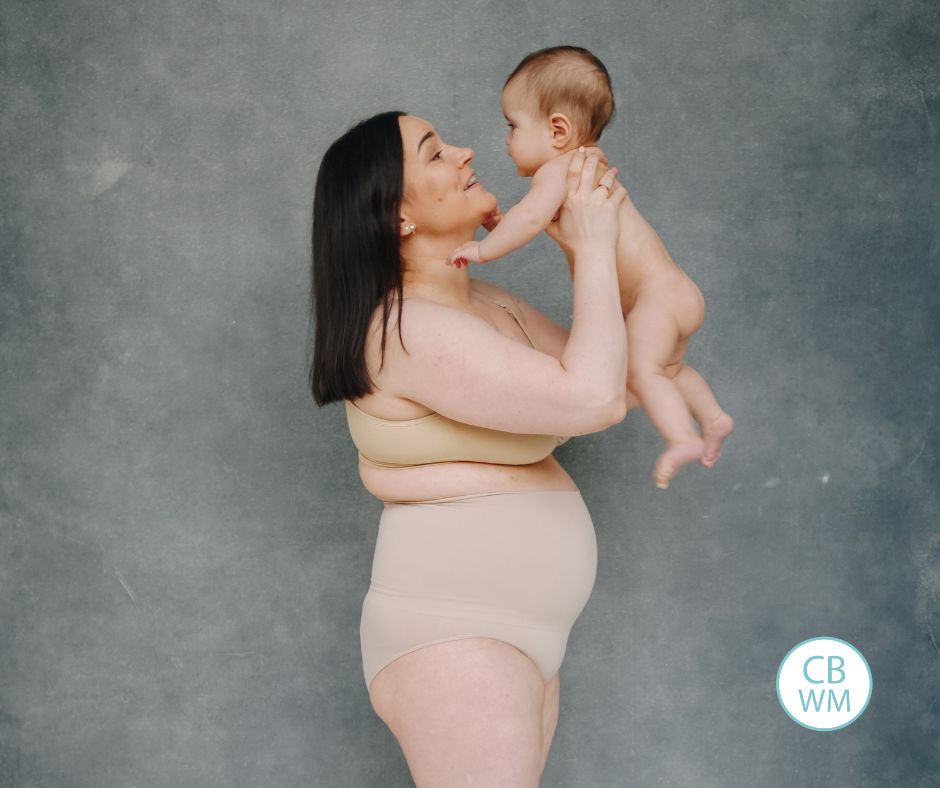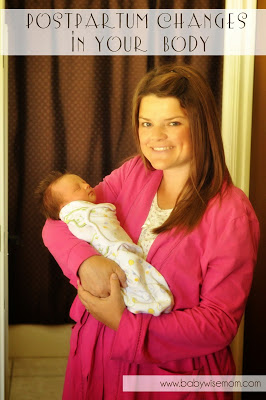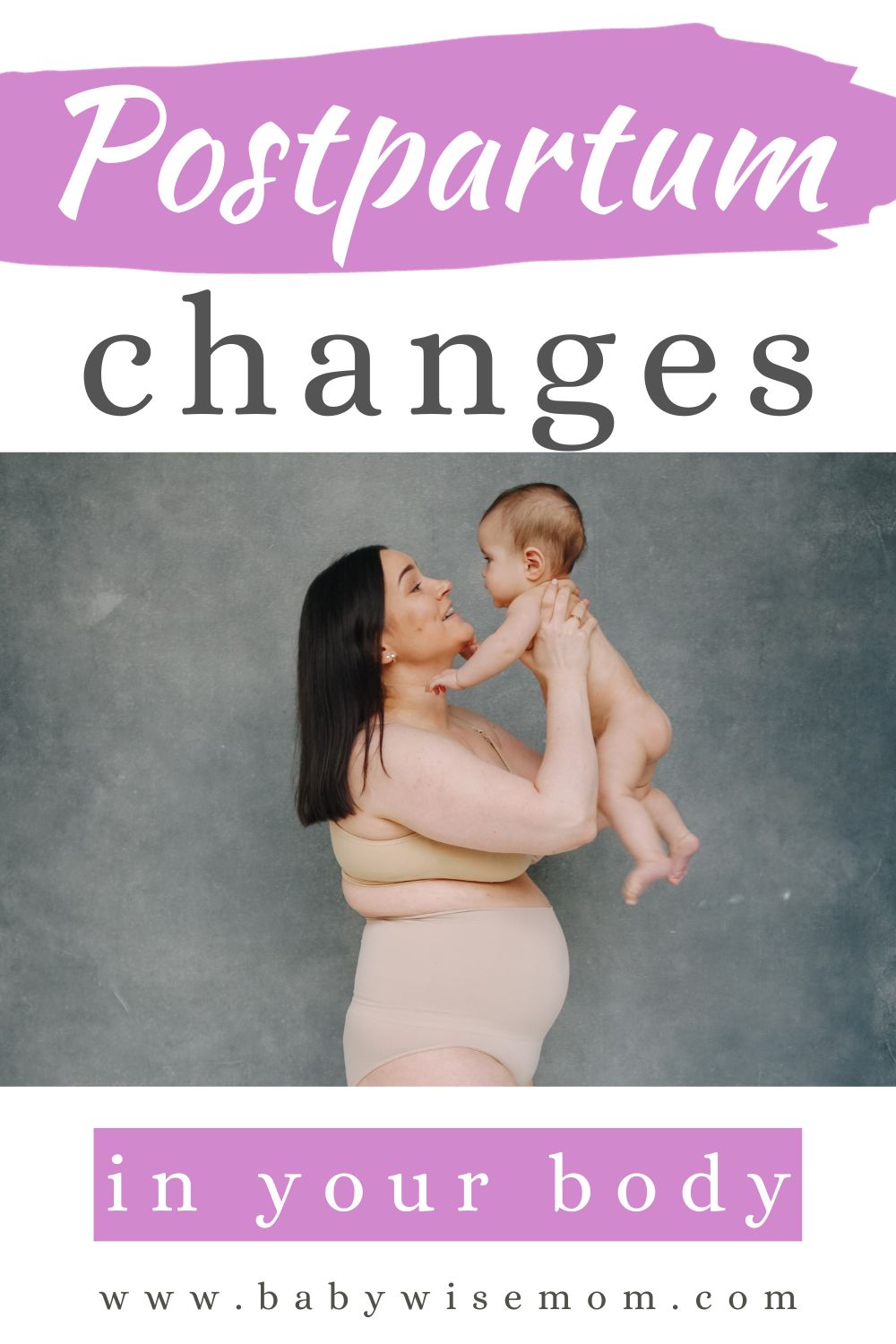After you deliver your baby, you will see a lot of changes in your body. Learn what to expect and what to do.

While I knew some basic facts of what to expect postpartum after I had Brayden, I didn’t have the full picture. And maybe you can’t until you have “been there.” Sometimes we try to warn and prepare each other about things but we never fully grasp it until we experience it for ourselves.
It is a good idea to know as much as you can about what to expect postpartum so you face them head-on and take care of them.
I find a frustrating thing in anything you read about this period is they say to eat well, exercise, and get lots of rest. Sure, sure. Yes, logically that all makes perfect sense.
Those are all good things for your body. But those are all things that are easier said than done! When Brayden was a baby, I remember many days when the evening rolled around and I realized I hadn’t even brushed my teeth yet that day! There were also many days I didn’t get a chance to eat until well after lunch time, and that is as a nursing mother! Sleep?!? Ha!
I had good intentions with exercise, but by the time I got him fed and ready for a nice walk, we would make it about 10 feet down the road before he was screaming his head off…
Happily, as I had more children, I was much better prepared and much more knowledgeable and able to get a lot more food, rest, and exercise than I had with Brayden. Plus I had the Babywise system to help keep my life in order! Knowing what you might be able to expect with your body can be helpful in making this postpartum period a bit easier.
Post Contents
BODY CHANGES TO EXPECT
I recently talked about how your body is different after delivering a baby–see it here in Postpartum Body. That was more of a “body image” post. Now I want to talk nitty-gritty.
Here is what is going to happen. Your uterus will go from about 2.5 pounds down to 2 ounces over the first six week (pages 193-194 in Your Pregnancy & Birth by The American College of Obstetricians and Gynecologists).
So because of that fact, know you will initially still look very pregnant. And there is a good chance that even when that uterus has shrunk, you will not be back to your pre-pregnancy size. Even if you are the same weight, things have been shifted around. I have found this to be truer with each baby I have.
And the bleeding. It seems nice that you get to have about 9 months off from your period during pregnancy…but postpartum you get to have lochia–which can last for as short as two weeks or even longer than a month. All with no tampon. You get to bleed into a pad that whole time. Awesome right?
And it isn’t just the inconvenience of bleeding and the grossness of the pad, but it adds to how long you are up each night. You have to change that pad through the night about as often as you are feeding your baby.
If you are nursing, each time you nurse, it will cause your uterus to contract more and I have found the blood flow to increase significantly during and right after breastfeeding your baby.
Want to know an embarrassing story? You may remember that Kaitlyn, my second born, was in the NICU. About a day after she was born, I was in the NICU feeding her. The babies were all in one room, so we weren’t in a nice private room. It was a “studio” NICU.
So I fed Kaitlyn, held her for a while, and then it was time to put her back for vitals to be checked. As I stood, blood gushed down my leg and onto the floor. The nurse, bless her, assured me that it happened all the time and not to worry about it.
Since that day, I always change my pad before each time I nurse my baby for at least the first week.
No matter how you delivered your baby, there will be pain associated. I don’t have cesarean tips (if you do, please feel free to share in the comments!). As for vaginal–I remember before I had babies my cousins once laughing about having no idea there would be ice packs involved postpartum and laughing maniacally about it. So here you go. If you deliver vaginally, you will be tender where the baby came out. You might need to ice it. More on this pain in the section below.
Now for the menstrual period. You might start 6 weeks postpartum, you might start over a year later. But before you have your first period, you will ovulate. “This means you can get pregnant before you even know you are fertile again” (page 195 in Your Pregnancy & Birth). Then even once it comes back, it doesn’t mean you will be on a regular cycle. And you will likely find it is different than it was before you are pregnant. Different timing, different pain intensity, different length of time.
 |
| me with Brinley–two days postpartum |
POSTPARTUM PAIN/DISCOMFORT
I don’t remember really thinking about the pain that might accompany the birth of a child. I expected pain during, but didn’t think much about after.
Remember how big the uterus is and how small it is going to get? Well, that can hurt as it gets smaller. This is called afterbirth pains. Most of us don’t notice it with our first baby, but these pains are loud and clear with the second and just get louder with each one it seems. This is your uterus contracting and relaxing as it shrinks. They typically are intense for a few days.
Remember how I mentioned the blood flow increasing significantly while breastfeeding? Well, so does the pain. In fact, after the birth of Kaitlyn and McKenna, the only pain I had was the afterbirth pain. I would take some Tylenol about 20 minutes before I nursed them so I could have some relief from the pain while nursing (I tore with Brinley so there was more pain than just the afterbirth pains).
Speaking of tearing, the tearing of the perineum really hurts! I had a third degree tear with Brayden and a second degree with Brinley. Having had two postpartum periods with tearing and two without, let me assure you that it hurts a lot more and recovery time is more painful and longer with the tearing. I was a bit shocked after Brinley after having had a couple of “vacations” from the pain. “They” say to do kegals to help the pain.
There are other ways to help. Even if you didn’t tear, there is a good chance you will be a bit tender and sore for a few days, which is understandable since you just pushed a baby out. This is when the ice pack comes in. Here are some ideas for helping this area heal faster and feel better:
- Ice pack–I use these the entire time that I am in the hospital.
- Witch hazel–I always buy extra of this to have at home to use after the hospital.
- Dibucaine ointment or cream–I always buy extra of this for home, too. This and witch hazel are most helpful for the tearing.
- Sizt baths–water is an amazing thing for helping things to heal. I do a sitz bath every day for 1-2 weeks and then any time I feel sore after that. I make a rule for myself that I have to do the sitz. I always do it around 1 PM–either just before or just after the feeding around that time of day.
- Water bottle–Use a water bottle that can be squeezed every time you urinate for a while.
- Pillow or doughnut–I didn’t need this with any of my girls, but it was a necessity after Brayden. I tore A LOT with him. Not only my third degree tear, but up into the birth canal as well. I had no shame with my doughnut. I even took it with me to Brayden’s two week appointment.
Hemorrhoids can definitely happen from all of the pushing from labor. The witch hazel helps here as does the sitz bath (seriously do the sitz bath–it is so helpful!). Creams can help with these also.
After Brayden was born, I was more than a bit scared to have a bowel movement. My first bowel movement postpartum was as equally anticipated as his was! It is normal to have a delay in the first bowel movement for you after delivering a baby. Short walks can help, fiber helps, water helps, and a stool softener helps. Some women suffer from incontinence after delivering a baby–if you are one, be sure to let your doctor know because your doctor can help.
After 2-4 days postpartum, the milk comes in. Now, after Brayden was born, I was in some pain. I have described lots of tearing, and with that came over 50 stitches. Things were tender. But that paled in comparison to the pain I experienced when my milk came in. Oh my pain! It was incredibly painful. The good news is that it was only this painful for me after Brayden, so if you had pain after your first baby, I hope you are like me and don’t with your subsequent. It is just mildly discomforting. If you are having pain, here are some tips found in Your Pregnancy & Birth.
- Wear a good-fitting bra. But let me tell you from experience, I found the underwire in bras to add TONS of pain, so if you are in a lot of pain, go for a bra without the underwire.
- Ice packs can help reduce swelling.
- Pain medication.
- Don’t express milk. Why? Because then your body keeps producing. However, I remember reading tips like that and didn’t do anything to relieve the pressure. With my girls, however, I would pump a bit of milk to help take the edge off of the swelling. It also helps prevent you from being so hard that baby can’t even latch. So if you are in a lot of pain, go ahead and pump enough for relief. Just don’t pump too much because your body will want to replace what you pumped.
And on top of all of this, you will be tired. You likely haven’t slept well in weeks since being 9 months pregnant is so uncomfortable. You delivered a child. Beyond physical stress of this, you have lost a lot of blood. You may have injuries (cesarean incision or tearing) that your body needs to work to fix. Then you add in taking care of a baby around the clock. You are tired!
Don’t be afraid to ask for help. I have a friend who has her babies sleep in the nursery at the hospital while she is there. She even has them feed the baby with a bottle for one feeding so she can get a 6 hour stretch of sleep in. And guess what? Her babies breastfeed successfully and love her just the same. I think it is a great idea because then you get to have some sleep initially. Once you go home, you likely won’t have the luxury of having a team of women who are very experienced at taking care of babies to watch your baby for a night. It isn’t for everyone, but if it is for you, go for it!
You can also get help at home. Get help with chores, with watching other kids, with being on baby duty so you can get a deep sleep…whatever you need.
Sleep if you can. “They” always say sleep when baby sleeps. This can work for your first baby, and maybe even sometimes for your second, but in reality, it just isn’t very possible after that. You will have other children to take care of and watch. You might need to go to bed early for a while as your body heals or live for naps on weekends when your husband is home.
Now, yes, you can do your best to set up some sleep time for you. You have a good shot. Older children can have rest time or independent playtime or even TV time while you and the baby sleep. But I find reality to mean that even if I am trying to nap, I am not in a deep sleep because I am in charge of watching the other kids. I need to attend to needs and make sure someone doesn’t go wandering outside or something while I am zonked out .
Don’t be afraid to say no to visitors at certain times. I have found some people want to come over late (and in newborn time I mean late to be after 9 PM). If you want to be in bed, it is okay to say no! Let people know if you are going to try to take a nap in the afternoons.
Pretty soon, you will probably wake up to find yourself drenched in sweat. Ugh! As if sleep wasn’t restful enough already. This is a result of hormones changing. I found this to be more problematic after my first baby–so I didn’t notice a huge problem with Brayden, but did with my girls. I would wake up drenched in sweat and then freeze to death every time I nursed because I was so wet. You can try sleeping on towels and changing them out each time you get up to nurse. I also keep a robe right there when I am nursing at night so I can put it on to stay warm. And flip the pillow over if you need to. Eww.
POSTPARTUM BLUES/SADNESS/DEPRESSION
You might also find yourself very anxious, sad, or even depressed. See my post Emotions for more on this topic.
SURVIVAL TIPS
For tips on making it through the postpartum period with more ease, see my post Postpartum Survival Tips. This covers everything from the physical, to the emotional, to the organizational.
Also, check out my post on the Storage Caddy for ideas for organizing things postpartum. I used one for baby stuff and one for my pads, witch hazel, peri bottle, and dibucaine ointment.
Related Posts
- Accepting and Loving Your Postpartum Body
- Postpartum Real Life
- Your Postpartum Body Will Be Different
- Postpartum Survival Tips for New Moms

